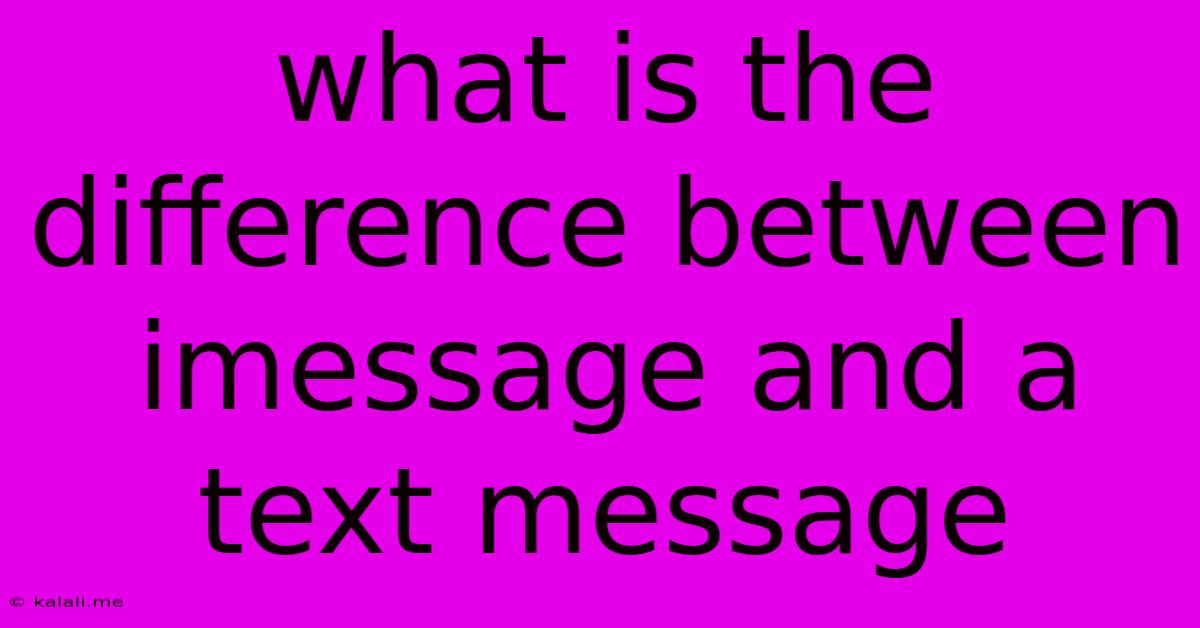What Is The Difference Between Imessage And A Text Message
Kalali
Jun 03, 2025 · 3 min read

Table of Contents
iMessage vs. Text Message: What's the Difference?
Choosing between iMessage and a text message might seem simple, but the differences go beyond just the color of the chat bubble. Understanding these nuances can significantly impact your communication experience, especially when considering factors like cost, features, and recipient compatibility. This article will break down the key distinctions between iMessage and standard text messages (often called SMS or MMS).
What is iMessage?
iMessage is Apple's proprietary messaging service, integrated seamlessly into iPhones, iPads, and Macs. It uses the internet (data) to send messages, photos, videos, and other media. This means it typically avoids SMS/MMS charges associated with traditional texting. Key features of iMessage include:
- Read Receipts: See when your message is read (unless the recipient disables this feature).
- Typing Indicators: Observe when the recipient is typing a reply.
- Rich Media Support: Send high-quality photos, videos, and audio files effortlessly.
- Group Messaging: Easily create and manage group chats with multiple participants.
- Reactions: Quickly respond to messages with emojis.
- End-to-End Encryption: Your messages are encrypted, providing a higher level of privacy.
- Cross-Device Syncing: Access your messages across all your Apple devices.
What is a Text Message (SMS/MMS)?
Text messages, utilizing the SMS (Short Message Service) and MMS (Multimedia Messaging Service) protocols, are the standard messaging systems supported by virtually all mobile phones. SMS allows for short text messages, while MMS extends this to include images, videos, and audio. Crucially, these messages are sent via your cellular network.
- Limited Media Support: MMS support for media is often less reliable and can result in lower quality.
- No Read Receipts/Typing Indicators: These features are usually not available.
- Carrier Charges: Sending and receiving text messages may incur charges depending on your mobile plan.
- Character Limits: SMS has strict character limits.
- Limited Group Messaging: Group messaging capabilities are often less robust.
Key Differences Summarized:
| Feature | iMessage | Text Message (SMS/MMS) |
|---|---|---|
| Data Usage | Uses internet data | Uses cellular data |
| Cost | Typically free (uses data allowance) | May incur charges depending on your plan |
| Media Support | Rich, high-quality media | Limited, lower quality |
| Read Receipts | Available | Usually unavailable |
| Typing Indicators | Available | Usually unavailable |
| Encryption | End-to-end encryption | Typically less secure |
| Compatibility | Only between Apple devices | Works between all phones |
When to Use Which:
-
iMessage: Ideal for communicating with other iPhone, iPad, and Mac users, where you value features like read receipts, typing indicators, and rich media support. It offers a more seamless and integrated experience within the Apple ecosystem.
-
Text Message (SMS/MMS): Essential for communicating with users on Android, Windows phones, or other non-Apple devices. It guarantees delivery regardless of the recipient's platform, although with fewer advanced features.
In Conclusion:
The choice between iMessage and a text message largely depends on your communication needs and the devices of those you're messaging. iMessage offers a richer, more feature-packed experience within the Apple ecosystem, while text messaging ensures broader compatibility across different platforms. Understanding these differences empowers you to select the most appropriate method for each communication scenario.
Latest Posts
Latest Posts
-
Hot Water Heater Not Hot Enough
Jun 05, 2025
-
Should I Flush My Water Heater After 5 Years
Jun 05, 2025
-
What Does I Dont Know Mean
Jun 05, 2025
-
How Much Do U Tip A Barber
Jun 05, 2025
-
What Does Ot Mean In A Text
Jun 05, 2025
Related Post
Thank you for visiting our website which covers about What Is The Difference Between Imessage And A Text Message . We hope the information provided has been useful to you. Feel free to contact us if you have any questions or need further assistance. See you next time and don't miss to bookmark.